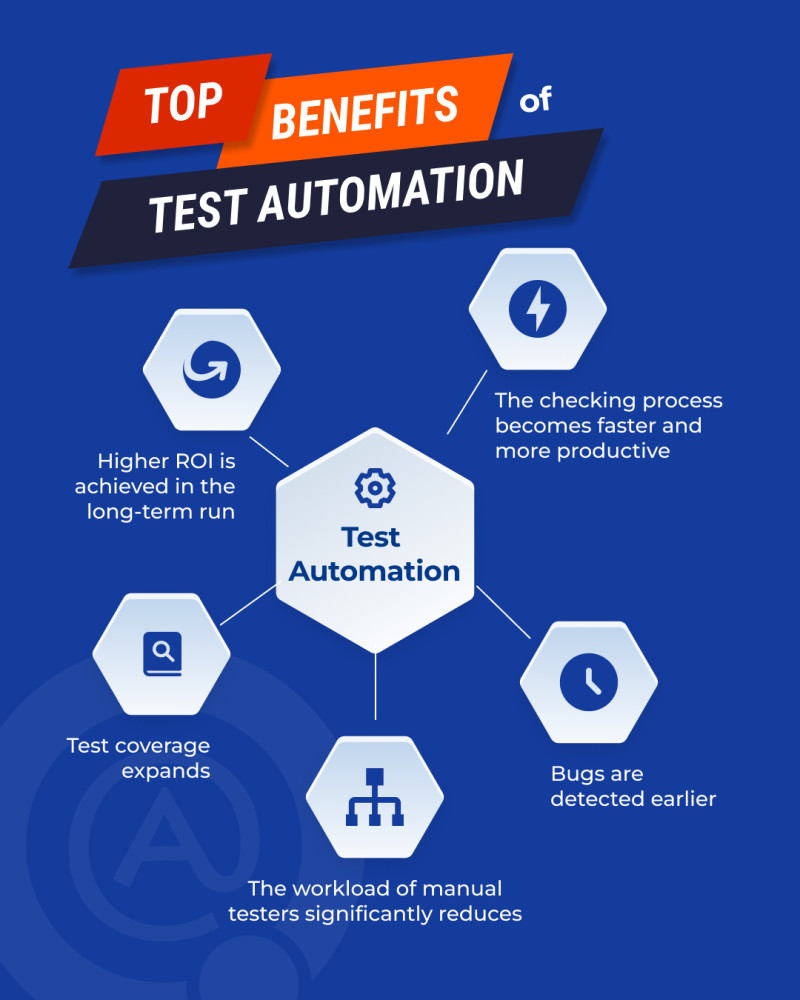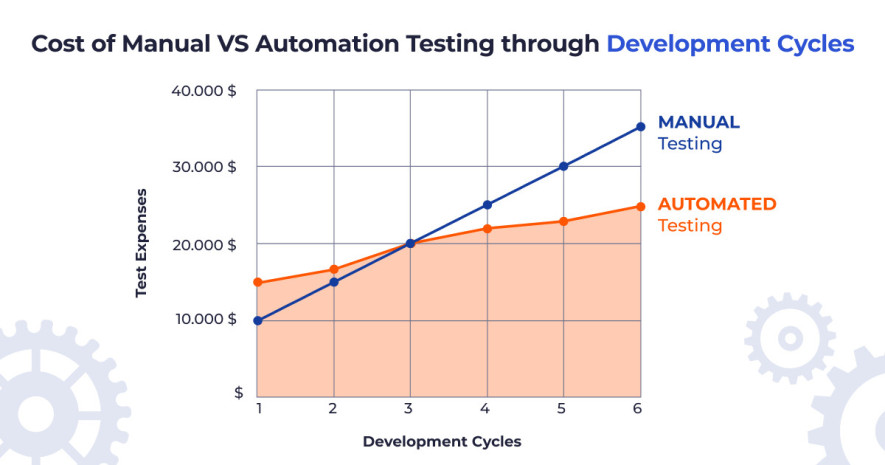- QATestLab Blog >
- Automated Testing >
- Test Automation Myths: Where the Truth Ends and the Myth Begins?
Test Automation Myths: Where the Truth Ends and the Myth Begins?

In the realm of Quality Assurance (QA), automation testing is often shrouded in misconceptions. Today, we aim to dispel these myths and reveal the true power of test automation, highlighting its numerous benefits that can transform your perspective on this valuable approach.
Big projects, tight deadlines, and repetitive tasks often lead tech teams to automation testing. But that’s just the start. Automation offers many more benefits. In the next visual, we’ve gathered the main benefits of implementing test automation.

If you’re new to automation testing, you might wonder: with so many benefits, why wouldn’t everyone use it? The truth is – there are many misconceptions surrounding automation testing, which can make developers unfamiliar with it feel apprehensive. However, this hesitation often stems from a lack of understanding about automation’s true potential.
To provide a well-rounded perspective, we’ve gathered the main myths about automation and consulted with our team of automation specialists. Let’s explore these concerns and address them directly.
Myth 1: Automation takes manual testers’ jobs
Busted: Automation isn’t here to replace manual testers, it’s here to empower them. By handling repetitive tasks, automation frees up manual testers to focus on more strategic initiatives like exploratory testing, adhoc testing and crafting high-impact test cases. Think of it as a productivity booster, not a job eliminator. This newfound division of labor ensures a balance between efficiency and in-depth analysis that includes the human factor, ultimately leading to a more reliable software product.
Myth 2: Upfront costs are a barrier
Busted: Yes, setting up automation requires an initial investment in tools, training, and process development. However, this investment pays off handsomely in the long run. Automated tests can be reused and executed much faster than manual ones, leading to significant time and resource savings, especially for regression testing. Imagine a project requiring hundreds of manual regression tests each sprint/release. Automating these tests would not only free up manual testers’ time but also drastically reduce the overall testing timeframe. This translates to faster release cycles and quicker time-to-market for your software.
Myth 3: Automation is a magic bullet
Busted: While automation excels at handling repetitive tasks, it’s not a silver bullet. Certain tests, like usability testing or those requiring human judgment, are better suited for manual execution. The key is to leverage both approaches for a well-rounded testing strategy. For instance, automated tests efficiently verify core functionalities, but they can’t replicate the intuitive understanding of a human user, who navigates the software’s interface. This combined approach ensures comprehensive coverage, identifying both technical bugs and potential usability issues that could hinder user experience.
Myth 4: Automation runs on autopilot
Busted: Automation isn’t entirely “set it and forget it.” While it handles the execution, human oversight is still crucial. Testers need to monitor test results, troubleshoot issues, and adapt as needed. It’s a collaborative effort between humans and machines. Think of it as a partnership. Automation acts as the tireless executor, running tests diligently. But Automation QA specialists take on the role of the insightful analyst, interpreting results, identifying patterns, and making adjustments to the automation suite when necessary, for example, when the functionality has changed and, accordingly, the tests need to be changed.
Myth 5: Test automation replaces manual testing
Busted: Automation complements manual testing, not replaces it. Manual testing remains essential for exploratory testing, user experience evaluation, and edge cases that might be difficult to automate effectively. Take user experience (UX) testing for example. Automating clicks and swipes might ensure basic functionality, but it can’t capture the user’s emotional response or identify aspects of the interface that feel clunky or confusing. Meanwhile, a skilled UX tester can provide invaluable insights by pinpointing areas that need improvement for optimal user satisfaction.
Myth 6: Automation catches every bug
Busted: Automation shines at finding repetitive bugs, but complex or unexpected issues might slip through the cracks. A combination of automated and manual testing is the best way to ensure comprehensive coverage. Think of it like a fisherman’s net. Automated tests cast a wide net, efficiently catching common bugs. But just like a net with a large mesh size might miss smaller fish, automation can miss intricate or unforeseen issues. Here’s where manual testing comes in, acting like a fine-mesh net that meticulously examines specific areas and uncovers those subtler bugs that automation might overlook. This combined approach ensures a thorough inspection, leaving no room for hidden defects to disrupt the software’s functionality.
Myth 7: Automation is prohibitively expensive
Busted: The initial investment in automation might seem daunting, but the long-term cost savings are significantly higher. Increased test coverage, reduced regression testing efforts, and faster release cycles all contribute to a return on investment (ROI) rate. There are numerous cases where manual regression testing takes weeks or even requires a dedicated team. But there is no need to hire additional team members to fasten the process, if you are using automation testing. All the repetitive tasks will be handled in a matter of hours, not days or weeks. This translates to cost savings that can be reinvested in further development or other initiatives, ultimately leading to a more efficient and financially sound software development process.
Myth 8: Test automation guarantees perfect coverage
Busted: Achieving 100% test coverage, even with automation, is a near-impossible feat. There will always be areas of the software that are difficult or impractical to automate entirely. This doesn’t diminish the value of automation, however. Think of it as fortifying a castle. Even the most impressive wall can’t cover every nook and cranny. But by strategically placing automated defenses, you significantly strengthen the overall security. In the same way, automation bolsters your testing strategy, identifying the majority of potential issues and allowing testers to focus on the remaining critical areas.
Final thoughts
Test automation is becoming increasingly popular among software development teams due to the benefits it can bring. When implemented properly, automated testing becomes more time and cost-efficient than manual with every additional development cycle.

As you can see, within several development cycles, manual testing still requires new investment, while the cost of automation remains the same. This way, it can bring a higher Return on Investment (ROI) in the future. You can find out more in our article on this topic.In times of economic slowdown, many businesses aim at transforming their processes into more efficient ones, while also saving resources. Test automation is one of the best tools to cope with those tasks in terms of QA, but it is important to remember that it requires an individual and careful approach. To ensure that you are able to use the full potential of automated testing, the team of QATestLab is always ready to come up with a customized solution for your software. Contact us and our experts from Automation Department will be at your service.





